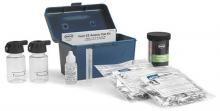
A cell-free sensor platform for the quantification of arsenic concentrations in drinking water.
Our team was challenged to develop a novel sensor technology utilising recent developments in cell free synthetic biology. It has already been shown that programmable biomolecular components can be used as part of a rapid, low cost detection method of viruses such as Zika.
The team identified an opportunity to use similar methods for the detection of heavy metals, focusing on arsenic concentrations in drinking water.
The contamination of groundwater by arsenic in Bangladesh is the largest poisoning of a population in history, with millions of people exposed.
World Health Organisation, 2000


Many countries have arsenic contaminated water supplies, and monitoring them is essential to the health of local people. The National Institute of Health highlighted the need for an affordable, reliable and easy to use test kit capable of accurately measuring arsenic concentrations whilst generating minimum chemical waste.
Objective
Current solutions are complicated to use, toxic and limited to a qualitative read out, our objective was to develop the prototype of a sensor which could be developed into a device more suited to well monitoring in affected countries.

We set out to develop a quantitative arsenic sensor, using electro-chemistry to obtain an electrical signal or fluorescence to go down the optical detection route.


The first image shows part of the electrode manufacturing process while the second image shows fluorescing samples.
Solution
We determined four main workstreams for the project: biology, electrochemistry, hardware, and data collection. Each workstream developed a prototype device:
- a cell-free extract which produces an enzyme in the presence of arsenic in water,
- a potentiostat and electrodes capable of detecting current changes on the scale of nA as a result of the production of enzymes,
- data collection infrastructure which allows to remotely collect data from the sensors, store it in a data base and present it in a userfriendly form.
The Team
The team consisted of 12 students with backgrounds in biology, biochemistry, chemistry, physics and engineering. We had to manage the project ourselves, from ordering product and budgeting to seeking advise from a number of academics and dividing-up tasks in order to employ every team member in the most effective manner.
 |
 |
 |
Sponsors
We gratefully acknowledge the support of our sponsors:






